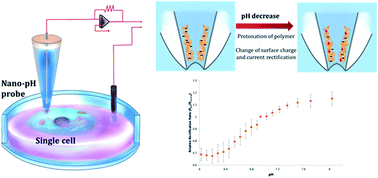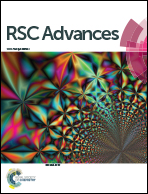Single-cell intracellular nano-pH probes†
Abstract
Within a large clonal population, such as cancerous tumor entities, cells are not identical, and the differences between intracellular pH levels of individual cells may be important indicators of heterogeneity that could be relevant in clinical practice, especially in personalized medicine. Therefore, the detection of the intracellular pH at the single-cell level is of great importance to identify and study outlier cells. However, quantitative and real-time measurements of the intracellular pH of individual cells within a cell population is challenging with existing technologies, and there is a need to engineer new methodologies. In this paper, we discuss the use of nanopipette technology to overcome the limitations of intracellular pH measurements at the single-cell level. We have developed a nano-pH probe through physisorption of chitosan onto hydroxylated quartz nanopipettes with extremely small pore sizes (∼100 nm). The dynamic pH range of the nano-pH probe was from 2.6 to 10.7 with a sensitivity of 0.09 units. We have performed single-cell intracellular pH measurements using non-cancerous and cancerous cell lines, including human fibroblasts, HeLa, MDA-MB-231 and MCF-7, with the pH nanoprobe. We have further demonstrated the real-time continuous single-cell pH measurement capability of the sensor, showing the cellular pH response to pharmaceutical manipulations. These findings suggest that the chitosan-functionalized nanopore is a powerful nano-tool for pH sensing at the single-cell level with high temporal and spatial resolution.



 Please wait while we load your content...
Please wait while we load your content...